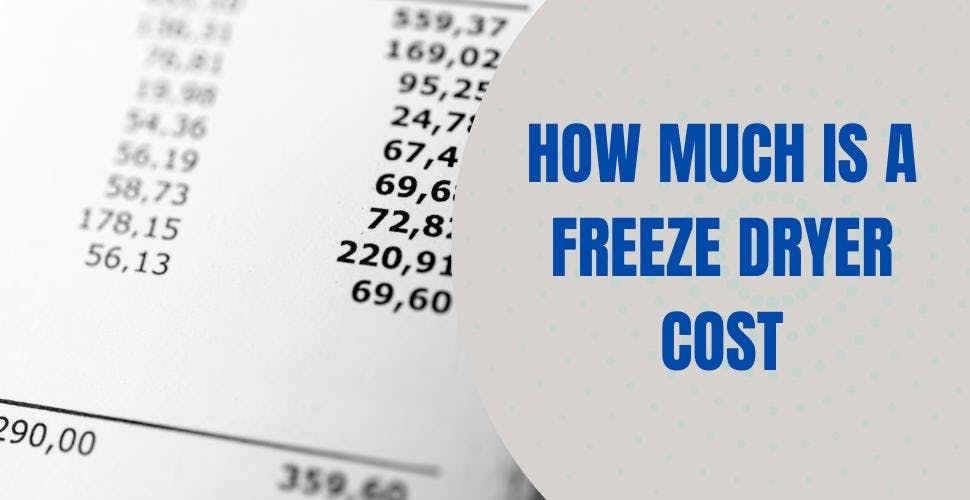Do Freeze Dryers Use a Lot of Electricity
 Dr. Tontul
Dr. Tontul- 10 Aug 2023

Freeze-drying, also known as lyophilization, is a popular method for preserving food, extending its shelf life, and transforming it into value-added products.
The freeze-drying process usually takes a long time, such as 24-36 hours, under low-temperature and high-vacuum conditions. Therefore, a concern that arises for freeze dryers is their high electricity consumption. Are they energy-efficient, or do they consume too much electricity?
In this article, we'll delve into the details of freeze dryer electricity usage, explore their energy efficiency, and provide insights on optimizing their performance.
Understanding Freeze Dryer Electricity Usage
Freeze dryers are powered by electricity. Power consumption varies depending on various factors such as brand, model, size, energy efficiency, and capacity. Therefore, these factors should be taken into consideration when evaluating the operating costs of freeze dryers.
Energy Efficiency
Freeze dryers are designed to optimize energy use during the freeze-drying process.
Look for models that are advertised as energy-efficient or have energy-saving features to minimize power consumption while maintaining the quality of freeze-dried products.
Drying Time
The duration of the freeze-drying cycle can impact overall energy consumption. Longer drying times may require more electricity.
Generally, bigger products require a longer duration to complete drying. Therefore, slicing or chopping can be applied to large products.
Size and Capacity
The size of the freeze dryer can affect electricity consumption. Larger freeze dryers with higher capacities may consume more electricity compared to smaller models.
Therefore, consider your specific needs and choose a size that aligns with the quantity of food you plan to freeze-dry.
Local Electricity Rates
The cost of electricity varies by location. Consider the electricity rates in your area and calculate potential running costs based on the energy consumption specifications provided by the manufacturer.
Usage Frequency
The frequency of use can impact running costs. If you plan to use the freeze dryer regularly, consider the ongoing electricity consumption associated with each use.
Electricity Consumption of Different Freeze Dryer Phases
Let's take a closer look at the electricity consumption of different phases of the freeze-drying process. Keep in mind that specific values may vary depending on the model and loading amount.
Freezing stage: The freezing cycle is the first phase of freeze drying. It can be done in an external freezer or in the freeze dryer itself.
In a freezer, freezing can be completed in several hours because of effective heat transfer. On the other hand, in a freeze dryer, it requires about 7-9 hours since heat transfer occurs through conduction.
Therefore, my advice is to carry out freezing in an external freezer to decrease electricity consumption.
Drying stage: In this stage, the heating, vacuum pump, and refrigeration system are running, and therefore electricity consumption is higher. Depending on the duration (generally between 8-12 hours) of this cycle and the size of the freeze dryer, electricity consumption in this cycle is between 4-10 kWh.
Heating is necessary for drying since the enthalpy of the material itself is not enough for the sublimation energy.
Final Drying stage: During the final drying, heating, vacuum pump, and refrigeration system are still running. Additionally, this stage is longer (generally between 12-14 hours) than the drying stage.
Therefore, energy consumption is the highest in this stage and around 6-15 kWh.
Total Electricity Consumption: The total electricity consumption for a complete freeze-drying process (including freezing, drying, and final drying) can amount to between 12-30 kWh in 24-36 hours of operation.
Since the residential electricity rate in the U.S. varies between 10.35 (Idaho) and 28.38 (California) cents per kilowatt-hour (kWh), the electricity cost ranges between $1.25-$8.5.
Therefore, the cost of drying is higher than dehydration. This is one of the main disadvantages of freeze-drying.
Optimizing Electricity Consumption
To optimize the electrical efficiency of the freeze dryer, it is crucial to consider the food size. Smaller foods have a shorter distance for water removal, which speeds up drying. Larger foods, on the other hand, require longer drying times and therefore consume more electricity.
Excessive product feeding to freeze drying prolongs the drying time. It also causes excessive ice accumulation in the cooling coils and adversely affects dryer performance. Therefore, overfeeding should be avoided.
On the other hand, insufficient product feeding increases the energy used per unit quantity.
Frequently Asked Questions (FAQ)
How much electricity does a freeze dryer use?
The electricity consumption of a freeze dryer is directly related to the drying time, loading amount, size, capacity, and usage frequency. Depending on these conditions, the total electricity consumption for a complete freeze-drying process (including freezing, drying, and final drying) can range between 12-30 kWh in 24-36 hours of operation.
How to decrease freeze dryer electricity consumption?
To decrease electricity consumption of freeze-drying, the size of the food and product loading amount must be optimized.
How much does it cost to run a freeze dryer?
A freeze-drying cycle consumes electricity between 12 and 30 kWh. Since the residential electricity rate in the U.S. varies between 10.35 (Idaho) and 28.38 (California) cents/kWh, the electricity cost ranges between $1.25-$8.5.
How much electricity does a Harvest Right freeze dryer use?
According to the Harvest Right website, running the freeze dryer costs about $1.00-$2.80 a day, depending on power costs in the area.
Conclusion
Freeze dryers do consume electricity, but they are designed to be energy-efficient, and their benefits outweigh the running costs. When considering the electricity consumption of freeze dryers, factors such as energy efficiency, loading amount, and drying time play crucial roles.
For those looking to optimize efficiency, loading the freeze dryer with an adequate amount of food to achieve optimal water removal rates is key. With proper consideration and understanding, freeze dryers can be a valuable investment for preserving and extending the shelf life of various foods, making them an excellent addition to any home or commercial kitchen.


